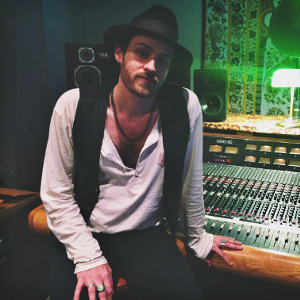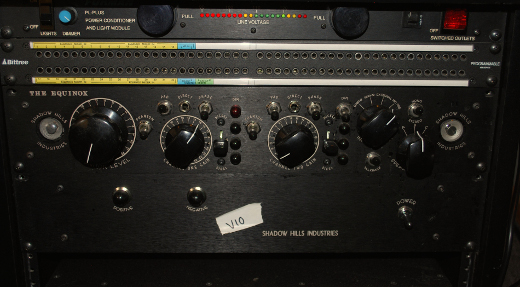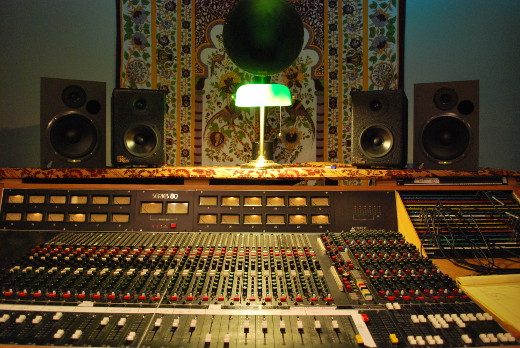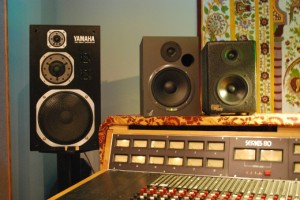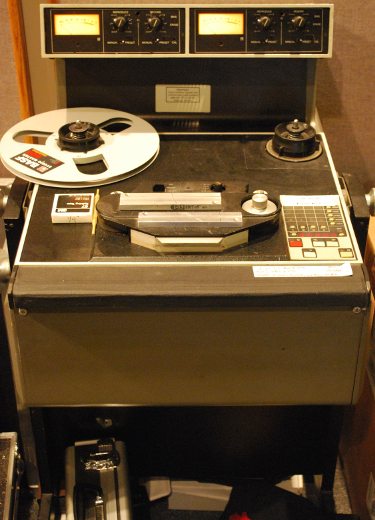Making the Mix Room: Matt “Linny” Linesch – Ocean Way Recording, Hollywood
It’s exhilarating to catch a rising star – and that’s exactly what’s captured here in the latest “Making the Mix Room.”
What makes Matt “Linny” Linesch shine so bright isn’t the obvious things, however. Yes, his mix credits are captivating – including the utterly distinctive 2013 self-titled album from Edward Sharpe and the Magnetic Zeros, as well as that band’s 2012 effort Here, the Golden Globe-winning soundtrack to All Is Lost starring Robert Redford, plus clients including Dave Mason, Fools Gold, the Australian band Wagons, Insects vs. Robots, and The Cerny Brothers.
And yes, his facility at Hollywood’s famed Ocean Way Recording – complete with a prized Trident 80b board — may be a mixer’s dream come true.
But what makes Linesch stay in your mind’s eye is the way he celebrates music. This multi-instrumentalist doesn’t just love it, he’s committed to always making it better and better. He accomplishes that with mixing, producing, engineering.
Linny also does it by enthusiastically sharing the considerable wisdom he’s built up in his young career. It’s a fact you’ll happily confirm yourself in a matter of moments, as you soak it in below…
Mixer Name: Matt “Linny” Linesch
Website: http://www.mattlinesch.com
Location: Ocean Way Recording, Hollywood, CA
Mix Philosophy:
Mixing is such an art form that I feel it takes a lifetime of trial and error to master.
Fortunately, I’ve been able to not only share studios with well-established mixers, but also have opportunities where I can make mistakes and learn from those mistakes to better my craft, while also working on a record that is going to reach a broad audience. These are two things that I am very grateful for in my career process.
My approach, not just to mixing, but also with my producing and music making in general, is always from a place of an artist/musician. I find that even more than the specific mix details which artists desire, an understanding of what the song means to the artist, where the song came from within them, helps me put myself in their shoes, and allows me to mix the song in a creative fashion, not just a technical way.
I recently mixed a record for a band called Wagons, and the lead singer (Henry Wagons) and I had quite a few conversations about where his head was at while writing the songs. Henry and his band are in Australia, so these were important conversations for me as he wasn’t just a phone call away most of the time.
Through this process, I was able to tap in to his creative flow, and ultimately mix the songs with very little input from him. Upon meeting in Los Angeles for the first time at the completion of mixing, Henry stated that working with me was the first time in his career he’s let go of so much control and been given a final product which so closely represented his vision.
Mixing is such a huge creative part of the process, and artists that recognize this importance will see their songs come to life and possibly surpass creative visions they might have had.
I enjoy mixing, and if it were just pushing up faders and EQing elements to fit together, I would be quite bored. Mixing is when we take all the recorded elements and put them together to create the experience that the artist/band heard in their heads the minute they started writing the song. I suppose this is also the producing side of me.
Even further then that, mixing is when we create the experience for the listener that they may have sitting in a crowd watching their favorite band perform, but feel that same experience through their home stereo, car stereo, and even little headphones (as difficult as that platform may be).
Clients/Credits:
Currently:
-Mixing various live Edward Sharpe and the Magnetic Zeros songs for upcoming projects.
-Mixing a jazz album that we recorded all analog. It’s been a change of my usual style of work, but recording and mixing a jazz record has been incredibly fun. I recorded the band in Studio B at Ocean Way, all together in the live room. I was very minimal with my microphone usage, as with that many musicians in one room I wanted to minimize as much phasing/bleed possibilities. We tracked to tape and then simultaneously dumped to Pro Tools at a high sample rate.
— Forthcoming self-titled The Fontaines EP (2014)
Previous Projects:
Wagons – Acid Rain and Sugar Cane (2014) – Mixer
Fools Gold – record #3 (2014) – Mixer
Valley Queen – 7” with White Iris (2014) – Mixer
Dave Mason – Future’s Past (2014) Producer/Engineer/Mixer
All Is Lost soundtrack (2013) – Engineer/Mixer
Edward Sharpe and the Magnetic Zeros – ESMZ (2013) – Engineer/Mixer
Beatles Reimagined – (2013) – Engineer
Estes Shane Whalen – Liguor Store (2013) – Mixer
Insects Vs. Robots – IVR (2013) – Producer/Engineer/Mixer
The Great Out West – (2013) – Engineer
Edward Sharpe and the Magnetic Zeros – HERE (2012) – Engineer/Mixer
The Cerny Brothers – The Cerny Brothers (2012) – Producer/Engineer/Mixer
Aaron Embry – Tiny Prayers (2012) – Engineer
Van Halen – A Different Kind of Truth (2012) – Assistant Mixing Engineer
Mojo Stone – Strange Honey (2012) – Producer/Engineer/Mixer
Handshakes – Villians and Crooks (2012) – Engineer/Mixer
Mojo Stone – Hatchet (2011) – Producer/Engineer/Mixer
Sputnik Monroe – The Great Depression Celebration Part II (2011) – Engineer
The Leisurlies – March to the Heart of the Sun (2011) – Producer/Engineer/Mixer
Tete – Le Premier Clair de l’Aube (2010) – Assistant Engineer
Mix Room Hunters:
I shared a studio with Edward Sharpe and the Magnetic Zeros in Ojai, CA for the past few years. That’s where we recorded and mixed ESMZ – Here (2012) and recorded ESMZ self titled (2013), along with the Golden Globe-winning score for All Is Lost (2013).
I mixed the ESMZ self-titled record in Studio B at Ocean Way in the beginning of 2013. We were here at Ocean Way for about 3 ½ months if I remember correctly, working nothing less then 16-18 hour days. Needless to say I got to know Rob Goodchild (studio manager) and his staff quit well.
So when we decided to move out of our Ojai studio, Rob offered me what was the mastering studio at Ocean Way as my new mix/production room. I jumped at the opportunity, as with moving back to Los Angeles, I was going to be establishing myself once again here, and what better way then to be right across the hall from my favorite studio in Los Angeles (studio B) and in the heart of the music industry. Having been the mastering room at Ocean Way, the room is incredibly tuned and was just asking to be a mix room.
Ocean Way has become quite the family and I am very grateful for this opportunity. Along with myself, the other residents here are Ricky Minor and the composer Christopher Walden.
Sound/Design:
I really lucked out with this room at Ocean Way. In all sincerity, this is the best sounding room I’ve ever worked in.
Fortunately, the previous tenant of this room was a mastering engineer named Alan Yoshido, who was very particular about the tuning of his room.
Once you walk through my lounge, you walk up a gradual incline in to my mix room. The room has floating floors, and treatment throughout the room. It’s a very dead room; with carpeting on the floors, but more then anything it’s an incredibly flat-sounding room. I’ve certainly been in more dead rooms, but this has just the right amount of live vs. dead. I’m hearing subtleties in my previous work that I never knew existed.
I haven’t changed any of my equipment since Ojai, which has helped a lot with the transition and diving in to work right away, but what an eye-opening experience being in a well-tuned room has been. I hear sonic differences channel to channel on my Trident Console, as well as a huge increase in definition of my monitors.
This brings me to my equipment!
I really love my setup, and I’ve been able to streamline it quite a bit. Because I work very quickly, if something takes me too long to do, I won’t do it. I suppose that’s the creative side of me more then the geek side.
I am currently running a Pro Tools 9HD3 system, with an internal UAD card. Consequently, I have my HD cards in an expansion chassis. Everything in my room is terminated to the patch bay of my Trident Series 80 console. I love my Trident console, and have found a new appreciation for the console since moving to Ocean Way. I find if I push the Trident just to the edge, there is a sweet spot that brings instruments/songs to life.
I get a lot of questions about whether I work in the analog world or digital world. The truth is I do both.
Along with my console, I have a couple of outboard Pulse Techniques EQP-1A3 Pultec EQs, a Thermionic Culture Ltd Pheonix valve stereo tube compressor, Dramastic Audio Obsidian stereo compressor, Distressor compressor, Retro Sta Level compressor, pair of LA4s, and a custom “Bus Boy” stereo compressor (which is essentially an SSL), the Equinox summing mixer, and finally an original EMT 140 Plate (which I love!!!).
Upon moving in to Ocean Way, the first record I mixed was the new Fools Gold record, which they tracked analog. I mixed it on the console and printed it to 2-track ATR, which is still living in my room these days.
My workflow typically begins in the box, but then I start using my outboard gear as inserts, then will stem out to the console. If I’m not digging how it sounds stemmed to the console I’ll try the Equinox summing mixer, which usually is the other solution. Every once in a while I may keep it within Pro Tools, but will always run through my Dramastic Obsidian compressor on my stereo bus.
Choice Pieces:
I absolutely love my Hot House PRM 165 Mk II monitors. They have a 6.5” long excursion woofer and are just the right size monitor for my room here. The beauty of these monitors is that not only are they flat as hell, but I rarely experience ear fatigue.
Trident Series 80 Console
Event 20/20 Active Monitors
Yamaha NS-1000 Monitors
Pulse Techniques EQP-1A3 Pultec EQs
Dramastic Obsidian stereo compressor
Distressor compressor
Thermionic Culture Ltd Pheonix stereo compressor
Retro Sta-Level
LA4 compressor
Bus Boy stereo compressor
Nagra 2-track tape machine
ATR 2-track tape machine
Equinox Summing mixer
Pro Tools TDM HD3
UAD plugins
Waves Diamond Bundle
AC30 tube amp
Fender Reverb tube amp
Tune Up:
This room has always been used either as a mix room or a mastering room. I knew the attention to detail that has been put in to this room; therefore, my main goal moving in was to connect with those that have used this room or built the room to find the sweet spot.
At first I found that my console/speakers were a bit too far back, which I heard mainly from listening to previous work I’ve done and noticing a loss in depth that seemed to dissipate right away. After moving the console further towards one end of the room, I found that all of a sudden I was sitting in a sweet spot where I could hear all frequencies clearly.
This is the first time that I truly can work and know that when I pop that song in to a car stereo, or send it over for mastering, that what I’m hearing here out of my Hot House monitors is exactly what I’m going to hear somewhere else. It’s a great feeling and a true testament to the importance of your workplace.
For Example:
-Edward Sharpe and the Magnetic Zeros songs on soundcloud:
Key songs to look at:
– This Life
– Man On Fire
– Please
– Give Me a Sign
– Better Days
– That’s What’s Up
-Alexander Ebert– Amen (from soundtrack of ALL IS LOST)
–Wagons (U.S. release date TBD) – Why Do You Always Cry
–Insects vs Robots songs on soundcloud:
Key songs to look at:– Mosquito
– Fej Gruv
–The Cerny Brothers songs on soundcloud
So You Want To Be A Better Mixer:
Mixing is a process that takes quite a bit of time to master. I still find myself dissecting my favorite albums in my free time, and besides shadowing established mixers, this is my other form of continued education.
Sometimes I create little assignments for myself. For example, at one point the tracks to some Bob Marley songs found their way in to my possession. For a couple days I took the time to mix the songs as closely to the originals as I could.
In some respects mixing is a time to be very analytical and put together the various elements of the songs so that nothing is sonically fighting with one another, but mixing is also a time to be creative. Some of my favorite mixes are when instruments and elements take on a life within the song unlike anything we may have expected.
Sometimes the only way to find that is through trial and error. Close your eyes and turn those knobs, push the faders, and try things without even looking to see what number you’re at, just use your ears. It’s important to take your time and really listen.
You haven’t mixed a song until it is speaking to you in a way that washes over you and makes you get lost in the song.
It’s easy to make everything loud and in your face, but what about the negative space in a song and the air that exists around instruments and vocals? In my mind that’s where the magic exists.
Anything Else?
Producing and making records is a lifelong journey. This is a passion as much as it is a career, and if you can push yourself to always continue learning, while also being assertive of what you can and know how to do, you will find yourself in great situations with some of the most talented people in our industry.
It’s important to be humble and know that we are all in this process together. No single person is bigger then the project, so know what you can bring to the table and work hard. Through that you will continue to learn.
Never stop learning and trying new things!
As you expand your knowledge, you will take risks and try new things, but from an educated place and most of the time they will produce a new and unique idea or element to a song!
— Matt “Linny” Linesch
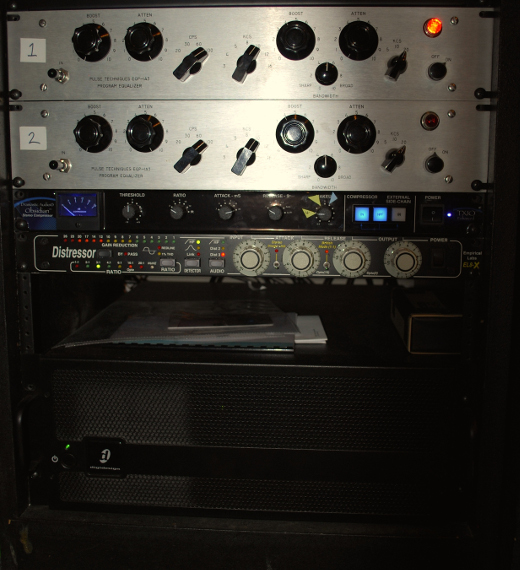
Outboard of the obsessed: Pulse Techniques EQP-1A3 Pultec EQs, a Dramastic Obsidian stereo compressor, and the essential Distressor.

Group shot! (L-R) Robin Goodchild, Ocean Way manager; Fool’s Gold’s Luke Top and Lewis Pesacov, and Matt “Linny” Linesch. Photo by David Goggin.
Please note: When you buy products through links on this page, we may earn an affiliate commission.







